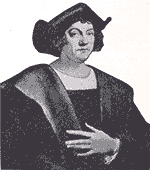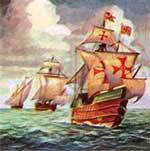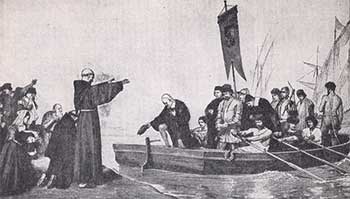(Italian), Critofor Columbo, or Spanish Cristóbal Colón, 1446?-1506
Columbus was the discoverer of the Americas and presumably born in Genoa, Italy, a city of seafarers. By the time Columbus was thirty years of age, he had gone to sea many times. On one voyage he is known to have sailed as far as Iceland. It's unclear when Columbus conceived the desire to sail west into unknown waters, but by age thirty he was eager to try this idea. Every nation in Europe was eager to find a shorter trade route to Asia which was rich in gold, silk and spices. Very little is known about the early life of Columbus. His father was a weaver, and according to some accounts Columbus followed in his father's trade at a young age. According to other accounts he attended the University of Pavia, where he took up studies of astronomy and cosmography. Little is known about his early career as a seafarer. It is known however, between 1474-1475 Columbus made voyage to the island of Chios, and in 1476 sailed a Genoese merchantman likely destined for England. Following these expeditions, he returned to Lisbon. There, around 1478 he married the daughter of Bartholomew Perestrello, a Navigator of Portuguese descent.

Christopher Columbus, 1446?-1506
Between 1482-1484 Columbus is believed to have made one or more voyages to the African Gold Coast. Along with many people of his time, Columbus began to believe the earth was round and Asia could be reached by sailing west, based on charts, maps and logs from his father-in-law and other sources. Columbus presented his theories to John II of Portugal, around 1482-1483 with petition for the finance of a voyage crossing the Atlantic, but was rejected.

Christopher Columbus at the court of a nobleman in Salamanca, from whom he attempts to secure financial aid for his westward expedition across the Atlantic.
Around 1484 Columbus moved from Portugal to Spain where his ideas gained support from the Count of Medina Celi, and other influential figures. Through the Count Columbus gained audience of Queen Isabella, but failed to obtain the royal patronage. Columbus, a widower at this time, acquainted Beatriz Enriquez, whom became mother of Ferdinand Columbus, the second son of Columbus.
Around six years following his audience with the Queen, Columbus began seeking support for his westward expedition in both Spain and Portugal, including by aid of his brother Bartholomew Columbus, in England and France. The Spanish sovereigns felt Columbus wanted too much reward if he was successful, a tenth of all riches, and to be made "Admiral of the Ocean Sea", but on his way to petition the King of France, on April 17, 1492, Columbus' persistence paid off when Ferdinand and Isabella agreed to subsidize the expedition. In contract, Catholic authorities included the provision he should become viceroy of all territories he might discover, including other privileges such as hereditary peerage and a tenth of any precious metals inside the jurisdiction.
Following a variety of delays, primarily, the difficulty of recruiting crews, the expedition alas was organized on August 3, 1492 to set sail from Palos, Spain with a total of 88 men, and from there, the ships sailed to the Canary Islands on September 9. The Santa Maria, a ship weighing about 100 tons and under the command of Columbus, the Pinta, a caravel weighing approximately 50 tons, commanded by Martín Alonso Pinzón and the Niña, another caravel of approximately 40 tons commanded by the brother of Pinzón, Vincent Yáñez Pinzón.

One of Christopher Columbus's Ship, the Santa Maria.
The Pinta was damaged three days after the expedition set sail, forcing a stop at Teneriffe. Columbus maintained his due west course until October 7th when he altered it a few points southwest. Crew members unable to understand the westerly variations on the compass and failure to find land began to demand return to Spain. Columbus is said to have urged them on by crying "Adelante! Adelante!" (Sail on! Sail on!) The demands turned into threats of mutiny, threats which were only averted by strong disciplinary action. Columbus kept a journal on the voyage, and an entry for October 10 reads, "Here the people could endure no longer.", but he persuaded them to sail on, and two nights later they sighted land.
The expedition made landfall early on the morning of October 12, on what is now known as Watlings Island, in the Bahamas. In solemn ceremony and thanksgiving, Columbus called it San Salvador and claimed the land in the name of the Spanish Sovereigns. Columbus sailed island to island, the men disappointed that no great riches or cities were discovered, only villages with dark-skinned people. Columbus believed he was near India so he called the natives "Indians". In the following weeks other discoveries were made including Cuba, which was named Juana by the Admiral in honor of the Spanish Princess and Española, later corruption as Hispaniola (believed by him to be Japan, Cypangu). Later, in December, the Santa Maria was wrecked on the coast of Española. Materials from the wreck were salvaged and a fort constructed, which they named La Navidad. The Niña and Pinta began the voyage home in early in January, 1493. Brief stops were made in Azores and Lisbon and Columbus arrived at Palos on March 15. He proceeded to Barcelona, to the Spanish court, carrying numerous specimens from the expedition with him. The Spanish Monarchs and people of Barcelona offered an enthusiastic reception, including confirmation of honors and, additional honors, the title of Don for Columbus and his brothers.

Christopher Columbus's departure on his famous voyage of discovery on August 3, 1492.
A second expedition resumed, which consisted of 3 galleons, 14 caravels and around 1500 men which set sail from Spain on September 24, 1493. New discoveries were made, including the islands of Dominica Guadalupe, Antigua and San Juan Bautista (Puerto Rico), marking the end of the voyage. The ships anchored on November 27 off La Navidad, along with the its garrison by the natives. A town was established by Columbus in Española. Columbus called it, Isabella, becoming the first permanent settlement of Europeans. Columbus set sail in the spring of 1494 to survey the coast of Cuba which he believed to be the Asiatic mainland, discovering numerous islands, including Jamaica.
During his voyage, Columbus became ill, and returned to Isabella on September 29. During his absence, dissent among the colonists had developed, some already en route to Spain to press grievance against the viceroy. A major problem for Columbus was the hostility of the natives, their initial friendliness alienated by the brutality of the dissidents. Columbus defeated the natives on April 25, 1495. He shipped a large group of them to Spain for sale as slaves, two months later.
A royal investigating committee arrived in Isabella, October 1495, and proved to be consistently critical of his policies. Leaving his brother Bartholomew in command, Columbus sailed for Spain in March 1496. Landing at Cadiz on June 11, Columbus reported directly to Ferdinand and Isabella, who dismissed the charges of the commission. New honors were conferred upon Columbus and a promise to subsidize a new expedition, consisting of 8 vessels, although nearly 2 years passed until the expedition was fulfilled.
Columbus' third voyage began May 30, 1498. On July 31 he discovered the island of Trinidad, named in honor of the Trinity. The following day Columbus sighted the mainland of South America, recognizing it was a continent after several days had elapsed from sailing along its coastline. Columbus made further discoveries of islands, including Margarita. Columbus then set course for Española, arriving at Santo Domingo on August 31 (today, known as Ciudad Trujillo, capital of the Dominican Republic), only to find part of the colonists in revolt against his brother's rule.
Columbus later succeeded in bringing the rebellious faction under control and intensified efforts to convert the Indian natives to Christianity and expanded operations for gold-mining. The enemies of Columbus had meanwhile convinced the Spanish monarchs Española had need of a new governor. On May 1499, the king gave order, appointing Francisco de Bobadilla to supersede as Governor of Española. Bobadilla arrived on August 23, 1500. Shackled in irons, Columbus and his two brothers Bartholomew and Diego Columbus were arrested and placed on a ship bound for Spain.
News arrived to the Monarchs shortly after the vessel arrived, on which Columbus was aboard. The monarchs shared in his indignation, resulting in his release and a substantial financial recompense. On December 17 Columbus was received by the monarchs, who repudiated the despotic action of Bobadilla, promising redress of the wrongs. The Monarchs did not reappoint Columbus to his position as viceroy, rather replacing Bobadilla with Nicolás de Ovando.
Columbus received royal support for his final expedition, a voyage in search of Portuguese Asia, but was restricted in size and quality. Four caravels were placed at his disposal but they were old and worm-eaten. Columbus was specifically forbidden to visit Española, the only point in the western seas with repair-facilities. The expedition which sailed May 9, 1502 from Cadiz found itself in need of repairs, and one of the caravels in sinking condition. On June 29, Columbus anchored near Santo Domingo but due to an approaching Hurricane, he was denied entry to harbor. The storm was weathered successfully by Columbus and his crew, but annihilated a homeward-bound ship on which a number of his enemies were passengers, including Bobadilla.

No contemporary image of Columbus exists. Photo by Columbus Historian Manuel Rosa
After completion of some repairs to his vessels at Jaquimo, Columbus sailed southwestward, and on January 24, 1503, making discovery of what is now known as Honduras. For nearly six months in search of westward passage, Columbus sailed along the coast of Central America. He landed on the coast of what is now called Panama, on January 24, 1503, establishing a settlement named Belem. This attempted settlement ended in failure due to trouble with his crew and aborigines, forcing him to give up on hope of colonization (April 1503). The expedition, now reduced to two caravels, stopped off at Cuba for food and water, then proceeding toward Jamaica. Columbus arrived June 23, 1503. Unable to continue, he sent dispatch to Española. Two relief vessels arrived after nearly a year for the stranded explorers, a delay which was purposely intended by the governor Ovando of Española. On June 28, 1504, Columbus and crew set sail for Santo Domingo, and from there setting sail to Spain, on September 12. The homeward voyage ended at San Lucar on November 7.
Columbus' final months, were spent in severe illness and futile attempts to secure himself royal restitution of honors and privileges. Columbus died in poverty in Valladolid on May 20 or May 21. Columbus died believing that America was only a group of islands on the way to the Far East. His remains, interred originally at Seville were transferred to Española in 1542, to Havana in 1795-96 and following Spanish relinquishment (1898) of Cuba, to the Cathedral of Seville in Spain.
Columbus was not the first European to reach America. Long before Columbus, Norsemen had sailed to North America, but these expeditions were little known, until centuries later.
References
- Adapted from an essay on Christopher Columbus, Funk and Wagnalls Encyclopedia, ©1950, Volume 8, pp. 2919-2999, with additional notes and image from The Golden Book Encyclopedia, Volume 4, ©1959


No comments:
Post a Comment